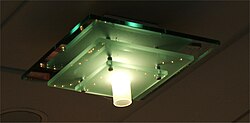
Low-iron glass is a type of high-clarity glass that is made from silica with very low amounts of iron. This low level of iron removes the greenish-blue tint that can be seen especially on larger and thicker sizes of glass. [1] Low-iron glass is used for aquariums, display cases, some windows, and other applications where clarity is desired. [2]
Low-iron glass typically has a ferric oxide content of about 0.01%. [1] Ordinary plate glass has about 10 times as much iron content.[ citation needed ] Low-iron glass is made from low-iron silica sand. In the United States, the primary sources for such sand are in Wisconsin. [3]
Fallingwater, a house designed by Frank Lloyd Wright and built in 1939, was one of the first houses to use low-iron glass for windows. [4]
Low iron glass is widely used in solar panels.
Low-iron glass is sold under various brand names. Guardian Industries calls it "UltraClear" or "Ultrawhite". [5] Pilkington calls it "Optiwhite". [6] Vitro calls it "Starphire". [7] Other brand names include "Starlite", "Krystal Klear", "Diamant" and "Eurowhite".